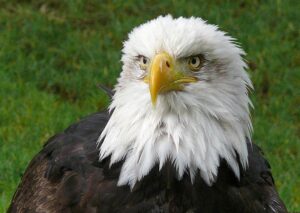Our Christmas Bird Count day had its challenges, like most years, during the short, dark days of December. Birding in the Denali area this time of year challenges even the most enthusiastic birders and the number of birds tallied on count day is often as dependent on temperature and snow conditions as it is sheer numbers of birds. Fortunately, to give a little broader perspective of the winter birds present, there is also a count week, which reflects the birds seen withing the count circle, in addition to the actual designated count day. During that period (but alas, not on the count day) several sightings of a bald eagle, flying along the corridor of the Nenana River were enjoyed by numerous observers. Given our weather since Christmas, (days and days where the temperatures lingered in the -30’s and -40’s F,) I am impressed that this bird of prey has been able to find any open water or enough food to sustain it through these difficult times.
The bald eagle is our national symbol and one of 59 species of eagles in the world, one of two eagles in North America (the other is the golden eagle) and the only exclusively North American eagle. Its scientific name is (Haliaeetus leucocephalus). Haliaeetus means “sea eagle” and leucocephalus refers to its white head. Majestic as it is in appearance, the eagle is not quite so majestic in its habits. It often feeds on carrion such as dead fish and it steals food from ospreys and other smaller birds. Although its total numbers have declined since Europeans came to North America, the banning of pesticides and intense recovery programs have increased populations that had been seriously diminished particularly in the East. This eagle is still fairly common in Alaska and most numerous on the coast. There are more bald eagles in Alaska than in all the other 49 states combined.

It is an enormous bird with long and wide wings (spanning more than 6 feet) for soaring. Typically, females are larger than males and juveniles can be larger than adults of the same sex but lighter in weight. It takes a young bald eagle four or five years to achieve the distinctive dark brown body that contrasts sharply with the white feathers on the head and tail, and the yellow beak, eyes and legs. Bald eagles are able to see three or four times farther than people can. They probably hear about as well as humans do but, judging by what they eat and by more scientific observations, their senses of taste and smell are poorly developed. To kill and handle prey, they are equipped with massive beaks, large talons and oversized feet with small spikes called spicules. Individuals may not breed every year. Some may mate for life, but if one partner dies or disappears, the other will take a new partner. Courtship involves elaborate and beautiful nuptial displays, with calls and aerobatics, including cartwheels, roller-coaster swoops and chases. Usually the pair builds its nest near fresh or saltwater in the tallest tree of large diameter, but where there are no trees, the birds have nested on cliffs, rock pinnacles or even on the ground in the northern tundra. Some bald eagles may remain in their breeding habitat year-round if their fishing areas do not freeze over. Many eagles, who breed in the far northern part of the Interior migrate south in winter in search of open water. Traveling alone or in pairs, most of these birds head south in autumn to the West Coast and return north in the late winter or early spring. They may or may not frequent the same nesting grounds and wintering areas each year.
The largest winter gathering of bald eagles on the continent is along the late-freezing Chilkat River in Alaska, where thousands gather from October to December to feed on salmon that have died after spawning.
Although bald eagles may live for 50 years in captivity, they are unlikely to live that long in the wild where they face natural hazards such as weather and human-caused threats, such as power lines, loss of habitat due to logging and development, and exposure to mercury and lead. About two-thirds of reported bald eagle deaths are due to shooting and incidental trapping by people and electrocution on and collisions with power lines.
Survival of eagles is lowest during the early years, especially the first winter, and less than half of the eagles produced may reach adulthood. However, if suitable habitat remains vailable and human disturbance is kept to a minimum, we should be able to enjoy this magnificent soaring bird for some time to come.




